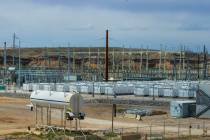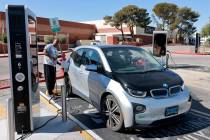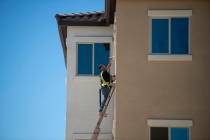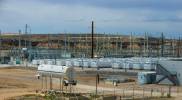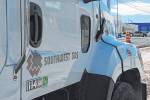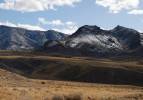NV Energy variable pricing program aims for conservation in summer
If you're conservation-minded, local electric utility NV Energy says it has a deal for you.
But if it's tough to curb your power use on summer afternoons, you might find yourself opting out of the company's proposed peak-pricing trial, which involves hot-weather rates that could run four to seven times beyond existing costs.
NV Energy has asked the Public Utilities Commission of Nevada to let the utility test whether higher power prices between 2 and 7 p.m. in Southern Nevada's four hottest months would encourage consumers to use less juice during high-demand hours. Getting ratepayers to power down at peak times would enable the utility to put off additional investments in new generation plants and avoid pricey wholesale power buys on open markets.
NV Energy says the pilot program could save participating ratepayers money over a year, but some consumer groups say they see worrisome trends in peak-pricing experiments. The public utilities commission will give ratepayers a chance to weigh in on the plan on Tuesday, in a consumer session scheduled for 6 p.m. at Cashman Convention Center inside meeting room 102. The center is at 850 Las Vegas Blvd. North.
Before you head downtown to register your opinion, it's important to understand how those new rates will work.
Start with NV Energy's current rate, which runs at a flat 11.5 cents per kilowatt hour, regardless of time of use.
For its voluntary peak-pricing trial, NV Energy has suggested rates ranging from 38 cents per kilowatt hour to 45.7 cents per kilowatt hour in July and August, and from 14.4 cents to 16 cents in June and September. During 14 critical peak events in July and August, rates would rise to 78.3 cents per kilowatt hour for up to four afternoon hours. Four such critical events in June and September would bring rates of 46.8 cents.
But the utility's off-peak rates on summer mornings and nights, and during the other eight months of the year, would fall to 7.2 cents per kilowatt hour. That is nearly 40 percent below today's flat fee.
So what does that all mean to your power bill?
If you don't sign up for the program, your rates won't change. If you do volunteer, your July and August bills could jump from their current $260 or so a month to around $425 a month, unless you cut your power use in the afternoon. If you manage to pare consumption by 5 percent during peak periods, and an additional 20 percent for an hour during those critical peak events, your bill would drop to around $408. Throw in a 40 percent consumption cut for four hours, and your invoice would fall to $388.
In every other month of the year, your bill would drop, in many cases drastically. From October through May, your charges would be more than a third below current costs under today's flat-rate regime. Your December invoice would drop from $123.68 to $80.10. Your May bill would fall from $127.63 to $82.55. Even your June and September bills would dip about 12 percent.
Add it all up, and there should basically be no effect on participants' average annual power bill, NV Energy officials said in their written testimony.
The typical household spends $1,760.64 a year on power under the flat rate. Peak-pricing volunteers will pay around $1,750 a year, even if they fail to modify their power habits. Ratepayers who do rein in their electric use could see their average annual expense decline to $1,662.19.
NV Energy officials said they designed peak pricing to be revenue-neutral, which means the program will not increase or slash the dollars the utility brings in from rates.
But some consumer groups said they're not so sure peak pricing will benefit ratepayers.
"I know this is optional, and I do think it's going to be opt-in and not opt-out," said Barry Gold, director of government relations for AARP Nevada. "But what's optional today may not be optional the next time around. And while this may be cost-effective for many people who are able to change their energy consumption, there are many people who, for a variety of reasons, can't really change their energy usage during peak periods."
Retired seniors, the disabled and stay-at-home parents with small children would have an especially tough time switching off air conditioning on sweltering summer afternoons, Gold said.
Gold added that he is concerned about how well trial participants will understand the experimental program.
"Are they really going to talk to people and let them know the pros and cons? Even if people are the very best energy savers, according to the most optimistic scenarios NV Energy has released, people's bills will still go up $123 in July and $129 in August (compared with current flat charges)," Gold said. "Are consumers going to know that when they sign up?"
Nor will NV Energy's pilot program provide an accurate representation of how the broader public would alter electricity use, Gold said. The trial's bigger price spikes in the summer will make it prohibitively expensive to people living on fixed or low incomes.
"AARP is very concerned that people who are living month to month are not going to be able to save or budget for fluctuations in their bills," he said.
State consumer advocate Eric Witkoski said Wednesday that his office is still evaluating NV Energy's filing. His agency, the attorney general's Bureau of Consumer Protection, will submit testimony on peak pricing in January.
NV Energy's filings contain answers to some of those consumer-related concerns.
Utility executives said in their testimony that they would allow trial participants to sign up for an annual payment plan, which charges a flat monthly fee based on their use over a year. That would mitigate some of those summer spikes, they said.
Also, NV Energy will offer bill protection for the first year of the two-year trial. The plan would guarantee that customers would not pay more annually by participating in the pricing trial than they would have shelled out by staying on the flat rate.
Volunteers could opt out of the program at the end of the first year.
And a consultant working with NV Energy described an informational plan combining print and online materials and interactions with NV Energy's installers and service associates. Experts from the University of Nevada in both Las Vegas and Reno are helping design a curriculum that will educate trial participants about electricity costs and rates, energy management and "the benefits of managing energy use in terms of savings, control and the community," the filing said.
NV Energy will spend $2 million on a consumer-confidence plan to build and maintain acceptance of the trial. The U.S. Department of Energy has granted NV Energy $1 million to help pay for the confidence plan.
If the Public Utilities Commission approves the proposal, the Southern Nevada peak-pricing trial will run from Jan. 1, 2012, through Dec. 31, 2013, and will cost $11.8 million to operate.
NV Energy said in its filings that it expects to defray the pilot's costs with Department of Energy funds.
To see the full testimony NV Energy has offered in the case, visit pucweb1.state.nv.us/pucn/. Click on "docket info," and choose "electric dockets." The docket number is 10-08014. The filings are labeled "testimony" and are dated Nov. 22.
Contact reporter Jennifer Robison at jrobison@reviewjournal.com or 702-380-4512.








